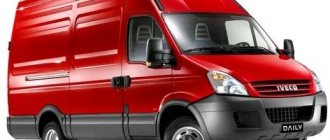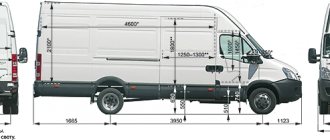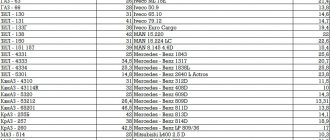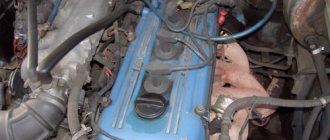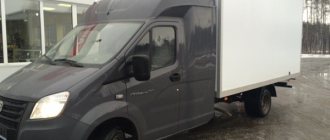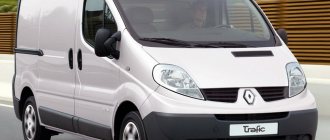Fuel consumption for Iveco Daily Diesel
Actions in emergency situations Daily checks and troubleshooting Vehicle operation and maintenance instructions Warnings and safety rules when working on a vehicle Basic tools, measuring instruments and methods of working with them Mechanical part of the 2.3 liter diesel engine (f1a) Mechanical part diesel engine with a volume of 3.0 l (f1c) Mechanical part of a diesel engine with a volume of 2.8 l (8140.xxx) Cooling system Lubrication system Power supply system Engine management system Intake and exhaust system Engine electrical equipment Clutch Gearbox Drive shafts and axles Suspension Brake system Steering control Body Passive safety Air conditioning system Vehicle electrical equipment and electrical circuits Explanatory dictionary
INTRODUCTION
In order to strengthen its position in the European market for vehicles with a gross weight of 3 to 6 tons, Iveco launched the next, third, generation of the Daily light commercial vehicle family in 1999. It is worth noting that models equipped with turbocharged engines are called TurboDaily. The range of models, depending on the load capacity (from 1.5 to 4 tons), includes three classes (L, S and C). The cars were produced with 8 wheelbase lengths and a total of almost 3,000 modifications. The main versions produced are: Van (van), Cab (chassis with cab) and Combi (cargo-passenger modification). In 2000, the new Iveco Daily received the prestigious title of “Van of the Year”, which undoubtedly indicates that Iveco engineers have coped with their task.
The organization of the driver's workplace brings the Daily closer to passenger cars in terms of ease of operation and comfort. Loading and unloading operations are facilitated thanks to the low loading height (680-735 mm), the presence of one or two side sliding doors with a width of 1100 mm and the installation of rear hinged doors that open to 270°.
Iveco Daily buses are perfect for comfortable transportation of passengers on urban and suburban routes.
How the suspension and chassis of the Iveco Daily family works
Iveco Daily - chassis
This family includes rear-wheel drive and all-wheel drive models. Rear-wheel drive versions are equipped with independent suspension, all-wheel drive versions are equipped with a threaded axle.
The car is built on a rigid frame, allowing the vehicle to be used on roads with any surface. Design features increase body rigidity and passenger safety.
An additional bonus for all-wheel drive versions are two sequential range-multipliers and an asymmetrical center differential. In addition, such cars have increased ground clearance.
The Iveco Daily family is available with several suspension options. A torsion bar suspension with anti-roll bar or an independent suspension with shock absorbers can be installed at the front. Suspensions on pneumatic elements or springs are provided for the rear part of the vehicle. For vehicles with air suspension, a height adjustment function is provided.
Iveco Daily - rear axle suspension
About Elitgaz: Owner reviews
| Iveco fuel consumption rate - IVECO fuel consumption At the same time, the quality of spare parts for IVECO engines always remains at the highest level, because the company’s factories always exercise strict control over production. and a displacement of 3 liters, equipped with a Twin Turbo turbocharging system with an intercooler, develops a maximum torque of 470 Nm; This is the first engine of this type to surpass the 200 hp mark. |
Qн = 0.01 x (Hsan x S + Hw x W) x (1 + 0.01 x D) • Iveco Daily buses are perfect for comfortable transportation of passengers on urban and suburban routes.
For what purposes is a car produced?
As mentioned above, it produces light and medium-tonnage vehicles. Light-duty vehicles successfully combine the comfort of a passenger car with the functionality of a truck. And their main purpose is to transport people or small goods within the city.
Iveco Daily - types
Vans produced by the Italian concern allow you to transport a wide variety of cargo, including food. They are equipped with sliding doors that provide an opening large enough to load Euro pallets. If necessary, the car body can be equipped with sliding doors on both sides of the car.
Iveco Daily has a unique platform that allows the installation of bodies for various purposes. Therefore, machines that are in demand in the construction industry, utilities and emergency services are produced on the basis of this model. For them, cars are produced with a double cabin that can accommodate 6 people.
In Russia, “Iveco Daily” is often used as a minibus, providing urban and suburban passenger transportation.
Features and operation
In order to strengthen its position in the European market for vehicles with a gross weight of 3 to 6 tons, Iveco launched the next, third, generation of the Daily light commercial vehicle family in 1999. It is worth noting that models equipped with turbocharged engines are called TurboDaily. The range of models, depending on the load capacity (from 1.5 to 4 tons), includes three classes (L, S and C). The cars were produced with 8 wheelbase lengths and a total of almost 3,000 modifications. The main versions produced are: Van (van), Cab (chassis with cab) and Combi (cargo-passenger modification). In 2000, the new Iveco Daily received the prestigious title of “Van of the Year”, which undoubtedly indicates that Iveco engineers have coped with their task.
Main characteristics of Iveco Daily
The technical characteristics of Iveco Daily depend on the class and purpose of the car.
| Operating weight | 3.3–7 t. |
| Maximum chassis load | 1.205–4.7 t. |
| Clearance | 21 cm |
| Wheelbase | 300–475 cm |
| Turning circle on outer wheel | 10.4–13.1 m |
| Overall turning radius | 11.5–14.4 m |
| Cargo compartment volume | 7.3–17.2 m3 |
| Sliding door dimensions | 110–125*141.5–178 cm |
| Tires | 225/65 R16 |
| Fuel tank capacity | 70 l |
The dimensions of Iveco Daily also depend on the class and load-carrying characteristics of the vehicle. Length can vary from 5077 to 7012 mm. The height of the cabin is 227–286.9 cm. Only the width of the vehicle remains unchanged, equal to 199.6 cm. The speed capabilities of the vehicle depend on the type of engine and design features of the transmission. On average, Iveco Daily is capable of moving at speeds of 146–179 km/h.
Advantages of the car and its versatility. Features and Benefits
| Technical information Iveco Daily / Iveco Turbo Daily since 1999 | Publishing house Monolit Thanks to the elasticity of the engine itself, you do not need to constantly change gears; in addition, in the Iveco Delhi model range there are cars equipped with an automatic transmission. where Hs is the basic fuel consumption rate for the mileage of an Iveco tractor in running order, l 100 km Hsan Hs, l 100 km, for a truck tractor; Hg fuel consumption rate for the additional weight of a trailer or semi-trailer, l 100 t. |
Driver's cabin • As soon as service is carried out here, the car is trouble-free no matter the weather.
Engine and transmission characteristics
Regardless of the model, Iveco Daly is equipped with engines running on diesel fuel. The engine has 4 liquid-cooled cylinders. Each cylinder has 4 valves.
Modern Iveco Dalys are equipped with “Multijet II” and “EEV” engines, which have the following characteristics:
Engine Iveco Daily 2.8TDI
- working volume – 2287–2998 cm3;
- power – 106–205 hp. With.;
- torque – 270–470 N.m.
All types of engines are the company's own development. They are equipped with a variable geometry turbine and an exhaust gas aftertreatment system.
In Russia and the former Soviet republics, engines with a displacement of 2287 cm3 are most widespread. According to consumers, they are characterized by economical fuel consumption and a high degree of reliability.
All Iveco Dailys are equipped with a six-speed gearbox. Depending on the model, the transmission can be automatic (Agile) or mechanical (ZF). Their distinguishing features are reliability and durability.
The company plans to soon begin producing vehicles with an eight-speed automatic transmission. The clutch in cars of this class is single-disc, hydraulically driven.
Iveco Daily gearbox - device
connecting rod
Designed primarily as a business assistant, Daily Business Up allows dispatchers to schedule jobs and communicate changes to their drivers in real time.
The engine of such a small-tonnage car is very reliable, truly durable and at the same time it can be considered economical. It was developed by Iveco Motors itself, which is why the engine fully meets the requirements for cars of this class. Just look at the 4-cylinder engine that all cars of the Iveco Daly family are equipped with. Absolutely all engines in this family are diesel, also 16-valve, in-line and, of course, equipped with a second-generation “Common Rail” direct fuel injection system and intercooled turbochargers.
Engines are divided into two types, with a displacement of 2.3 liters and 3.0 liters. It is these volumes that help ensure the ideal ratio of engine mass and power.
All mechanical parts were carefully worked out and precise adjustments were made to the electronic equipment itself, which, in turn, led to the lowest fuel consumption. Iveco produces all the necessary units for Daly exclusively on its own, which is why we can talk about achieving such indicators as power with minimal fuel consumption.
The designers did not forget about reducing operating costs. For example, the interval for replacing the engine oil and oil filter itself will be 40,000 km, while the air filter can be replaced at 80,000 km (in Russia this figure is 20,000 km). The operation of the engine itself truly gives only one pleasure when driving this car. The constant value of the torque itself over a fairly wide speed range makes it easy to achieve such powerful characteristics; the excellent dynamics of the car itself will be optimal under absolutely any driving conditions. The driver and passengers can appreciate the performance of the engine, since it operates almost silently in the Iveco Daily.
Chassis • Features and Benefits
| Iveco Daily 2. 3, 3. 0 real reviews of fuel consumption: diesel A choice of modifications is offered that have single or even double rear wheels, have bodies of very different lengths and 6 wheelbases. Its strength is ensured by a unique ladder frame chassis constructed with special steel C-section side members, allowing maximum creativity for superstructure builders. |
- First option: 96 hp with an available speed of 2900 or 3900, and with a range of 1800-2800 rpm, the maximum torque reaches 240 Nm.
- Second option: 116 hp. with an available speed of 3100 or 3900, and with a range of 1800-300 rpm, the maximum torque reaches 270 Nm.
- Finally, the third option: 136 hp. with an available speed of 3600 or 3900, and with a constant range of 1700-2900 rpm, the maximum torque reaches 320 Nm.
Line of motors • Systematic maintenance of the motor is the key to its normal operation.
Chassis equipment:
| IVECO 65C15 S/C | |
| ABS + ASR + Electronic Stability Program (ESP) | + |
| Generator 110A (12V) | + |
| Chassis without superstructure | + |
| Driver's seat on air suspension with adjustable lumbar support | + |
| Exhaust in the center | + |
| Multi-leaf rear springs | + |
| Fuel filler neck on the cabin | + |
| Standard heated fuel filter | + |
| Fuel tank 100 l | + |
| Standard stove | + |
| Instrument panel "Comfort" | + |
| 12-pin connector for connecting external electrical equipment | + |
| Standard key with immobilizer | + |
| External rear view mirrors on long brackets | + |
| 2-person passenger seat with 3-point safety belts | + |
| Main gear ratio 4.556 | + |
| Rear bumper | + |
| Seat upholstery - fabric | + |
| Standard chassis color | + |
| Electronic tachograph | + |
| Forced speed limiter up to 90 km/h | + |
| Standard steering wheel | + |
2.3 liter engine Features and operation
| I took a gas Iveco Daily Blue Power: how much did I save on refueling and what problems are there? Its strength is ensured by a unique ladder-type frame chassis, designed with C-shaped side elements made of special steel, which leaves maximum scope for creativity for superstructure manufacturers. The constant value of the torque itself over a fairly wide speed range makes it easy to achieve such powerful characteristics; the excellent dynamics of the car itself will be optimal under absolutely any driving conditions. |

